- Home
- Edgar Allan Poe
The Works of Edgar Allan Poe — Volume 3 Page 17
The Works of Edgar Allan Poe — Volume 3 Read online
Page 17
CHAPTER 16
It had been Captain Guy’s original intention, after satisfying himselfabout the Auroras, to proceed through the Strait of Magellan, andup along the western coast of Patagonia; but information received atTristan d’Acunha induced him to steer to the southward, in the hope offalling in with some small islands said to lie about the parallel of60 degrees S., longitude 41 degrees 20’ W. In the event of hisnot discovering these lands, he designed, should the season provefavourable, to push on toward the pole. Accordingly, on the twelfth ofDecember, we made sail in that direction. On the eighteenth we foundourselves about the station indicated by Glass, and cruised for threedays in that neighborhood without finding any traces of the islandshe had mentioned. On the twenty-first, the weather being unusuallypleasant, we again made sail to the southward, with the resolution ofpenetrating in that course as far as possible. Before entering upon thisportion of my narrative, it may be as well, for the information of thosereaders who have paid little attention to the progress of discovery inthese regions, to give some brief account of the very few attempts atreaching the southern pole which have hitherto been made.
That of Captain Cook was the first of which we have any distinctaccount. In 1772 he sailed to the south in the Resolution, accompaniedby Lieutenant Furneaux in the Adventure. In December he found himself asfar as the fifty-eighth parallel of south latitude, and in longitude 26degrees 57’ E. Here he met with narrow fields of ice, about eight or teninches thick, and running northwest and southeast. This ice was in largecakes, and usually it was packed so closely that the vessel had greatdifficulty in forcing a passage. At this period Captain Cook supposed,from the vast number of birds to be seen, and from other indications,that he was in the near vicinity of land. He kept on to the southward,the weather being exceedingly cold, until he reached the sixty-fourthparallel, in longitude 38 degrees 14’ E. Here he had mild weather, withgentle breezes, for five days, the thermometer being at thirty-six. InJanuary, 1773, the vessels crossed the Antarctic circle, but did notsucceed in penetrating much farther; for upon reaching latitude 67degrees 15’ they found all farther progress impeded by an immense bodyof ice, extending all along the southern horizon as far as the eye couldreach. This ice was of every variety--and some large floes of it, milesin extent, formed a compact mass, rising eighteen or twenty feet abovethe water. It being late in the season, and no hope entertained ofrounding these obstructions, Captain Cook now reluctantly turned to thenorthward.
In the November following he renewed his search in the Antarctic. Inlatitude 59 degrees 40’ he met with a strong current setting to thesouthward. In December, when the vessels were in latitude 67 degrees31’, longitude 142 degrees 54’ W., the cold was excessive, with heavygales and fog. Here also birds were abundant; the albatross, thepenguin, and the peterel especially. In latitude 70 degrees 23’ somelarge islands of ice were encountered, and shortly afterward the cloudsto the southward were observed to be of a snowy whiteness, indicatingthe vicinity of field ice. In latitude 71 degrees 10’, longitude 106degrees 54’ W., the navigators were stopped, as before, by an immensefrozen expanse, which filled the whole area of the southern horizon. Thenorthern edge of this expanse was ragged and broken, so firmly wedgedtogether as to be utterly impassible, and extending about a mile to thesouthward. Behind it the frozen surface was comparatively smooth forsome distance, until terminated in the extreme background by giganticranges of ice mountains, the one towering above the other. Captain Cookconcluded that this vast field reached the southern pole or wasjoined to a continent. Mr. J. N. Reynolds, whose great exertions andperseverance have at length succeeded in getting set on foot a nationalexpedition, partly for the purpose of exploring these regions, thusspeaks of the attempt of the Resolution. “We are not surprised thatCaptain Cook was unable to go beyond 71 degrees 10’, but we areastonished that he did attain that point on the meridian of 106 degrees54’ west longitude. Palmer’s Land lies south of the Shetland, latitudesixty-four degrees, and tends to the southward and westward farther thanany navigator has yet penetrated. Cook was standing for this land whenhis progress was arrested by the ice; which, we apprehend, must alwaysbe the case in that point, and so early in the season as the sixthof January--and we should not be surprised if a portion of the icymountains described was attached to the main body of Palmer’s Land,or to some other portions of land lying farther to the southward andwestward.”
In 1803, Captains Kreutzenstern and Lisiausky were dispatched byAlexander of Russia for the purpose of circumnavigating the globe. Inendeavouring to get south, they made no farther than 59 degrees 58’, inlongitude 70 degrees 15’ W. They here met with strong currents settingeastwardly. Whales were abundant, but they saw no ice. In regard to thisvoyage, Mr. Reynolds observes that, if Kreutzenstern had arrived wherehe did earlier in the season, he must have encountered ice--it was Marchwhen he reached the latitude specified. The winds, prevailing, as theydo, from the southward and westward, had carried the floes, aided bycurrents, into that icy region bounded on the north by Georgia, eastby Sandwich Land and the South Orkneys, and west by the South Shetlandislands.
In 1822, Captain James Weddell, of the British navy, with two very smallvessels, penetrated farther to the south than any previous navigator,and this, too, without encountering extraordinary difficulties. Hestates that although he was frequently hemmed in by ice before reachingthe seventy-second parallel, yet, upon attaining it, not a particle wasto be discovered, and that, upon arriving at the latitude of 74 degrees15’, no fields, and only three islands of ice were visible. It issomewhat remarkable that, although vast flocks of birds were seen, andother usual indications of land, and although, south of the Shetlands,unknown coasts were observed from the masthead tending southwardly,Weddell discourages the idea of land existing in the polar regions ofthe south.
On the 11th of January, 1823, Captain Benjamin Morrell, of the Americanschooner Wasp, sailed from Kerguelen’s Land with a view of penetratingas far south as possible. On the first of February he found himself inlatitude 64 degrees 52’ S., longitude 118 degrees 27’ E. The followingpassage is extracted from his journal of that date. “The wind soonfreshened to an eleven-knot breeze, and we embraced this opportunityof making to the west; being however convinced that the farther wewent south beyond latitude sixty-four degrees, the less ice was to beapprehended, we steered a little to the southward, until we crossedthe Antarctic circle, and were in latitude 69 degrees 15’ E. In thislatitude there was no field ice, and very few ice islands in sight.”
Under the date of March fourteenth I find also this entry. “The sea wasnow entirely free of field ice, and there were not more than a dozen iceislands in sight. At the same time the temperature of the air and waterwas at least thirteen degrees higher (more mild) than we had ever foundit between the parallels of sixty and sixty-two south. We were nowin latitude 70 degrees 14’ S., and the temperature of the air wasforty-seven, and that of the water forty-four. In this situation I foundthe variation to be 14 degrees 27’ easterly, per azimuth.... Ihave several times passed within the Antarctic circle, on differentmeridians, and have uniformly found the temperature, both of the air andthe water, to become more and more mild the farther I advanced beyondthe sixty-fifth degree of south latitude, and that the variationdecreases in the same proportion. While north of this latitude, saybetween sixty and sixty-five south, we frequently had great difficultyin finding a passage for the vessel between the immense and almostinnumerable ice islands, some of which were from one to two miles incircumference, and more than five hundred feet above the surface of thewater.”
Being nearly destitute of fuel and water, and without properinstruments, it being also late in the season, Captain Morrell was nowobliged to put back, without attempting any further progress to thewestward, although an entirely open, sea lay before him. He expressesthe opinion that, had not these overruling considerations obliged him toretreat, he could have penetrated, if not to the pole itself, at leastto the eighty-fifth parallel. I have given his ideas
respecting thesematters somewhat at length, that the reader may have an opportunity ofseeing how far they were borne out by my own subsequent experience.
In 1831, Captain Briscoe, in the employ of the Messieurs Enderby,whale-ship owners of London, sailed in the brig Lively for the SouthSeas, accompanied by the cutter Tula. On the twenty-eighth of February,being in latitude 66 degrees 30’ S., longitude 47 degrees 31’ E., hedescried land, and “clearly discovered through the snow the blackpeaks of a range of mountains running E. S. E.” He remained in thisneighbourhood during the whole of the following month, but was unableto approach the coast nearer than within ten leagues, owing to theboisterous state of the weather. Finding it impossible to make furtherdiscovery during this season, he returned northward to winter in VanDiemen’s Land.
In the beginning of 1832 he again proceeded southwardly, and on thefourth of February land was seen to the southeast in latitude 67 degrees 15’longitude 69 degrees 29’ W. This was soon found to be an island near theheadland of the country he had first discovered. On the twenty-first ofthe month he succeeded in landing on the latter, and took possession ofit in the name of William IV, calling it Adelaide’s Island, in honourof the English queen. These particulars being made known to the RoyalGeographical Society of London, the conclusion was drawn by that body“that there is a continuous tract of land extending from 47 degrees30’ E. to 69 degrees 29’ W. longitude, running the parallel of fromsixty-six to sixty-seven degrees south latitude.” In respect to thisconclusion Mr. Reynolds observes: “In the correctness of it we byno means concur; nor do the discoveries of Briscoe warrant any suchindifference. It was within these limits that Weddel proceeded south ona meridian to the east of Georgia, Sandwich Land, and the South Orkneyand Shetland islands.” My own experience will be found to testify mostdirectly to the falsity of the conclusion arrived at by the society.
These are the principal attempts which have been made at penetrating toa high southern latitude, and it will now be seen that there remained,previous to the voyage of the Jane, nearly three hundred degrees oflongitude in which the Antarctic circle had not been crossed at all.Of course a wide field lay before us for discovery, and it was withfeelings of most intense interest that I heard Captain Guy express hisresolution of pushing boldly to the southward.

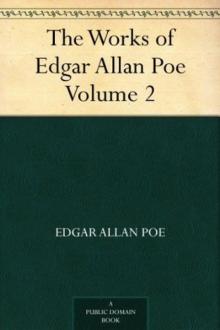 The Works of Edgar Allan Poe — Volume 2
The Works of Edgar Allan Poe — Volume 2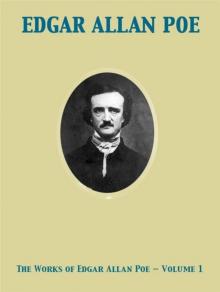 The Works of Edgar Allan Poe — Volume 1
The Works of Edgar Allan Poe — Volume 1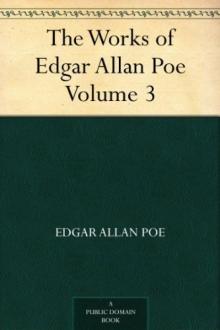 The Works of Edgar Allan Poe — Volume 3
The Works of Edgar Allan Poe — Volume 3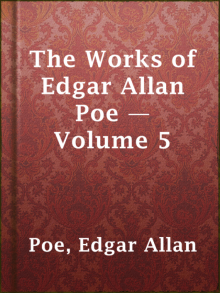 The Works of Edgar Allan Poe — Volume 5
The Works of Edgar Allan Poe — Volume 5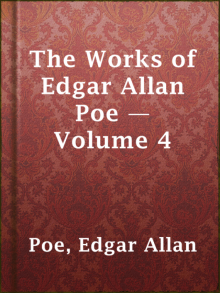 The Works of Edgar Allan Poe — Volume 4
The Works of Edgar Allan Poe — Volume 4 The Tell-Tale Heart
The Tell-Tale Heart The Raven (Penguin)
The Raven (Penguin) The Paris Mysteries
The Paris Mysteries Tales of Terror from Edgar Allan Poe
Tales of Terror from Edgar Allan Poe The Fall of the House of Usher
The Fall of the House of Usher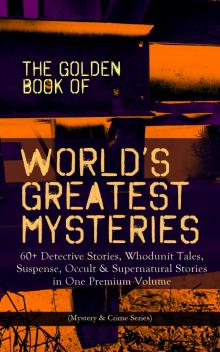 The Golden Book of World's Greatest Mysteries
The Golden Book of World's Greatest Mysteries The Narrative of Arthur Gordon Pym of Nantucket
The Narrative of Arthur Gordon Pym of Nantucket Ligeia
Ligeia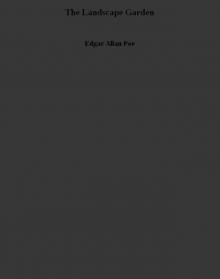 The Landscape Garden
The Landscape Garden Complete Tales & Poems
Complete Tales & Poems Great Tales and Poems of Edgar Allan Poe
Great Tales and Poems of Edgar Allan Poe The Colloquy of Monos and Una
The Colloquy of Monos and Una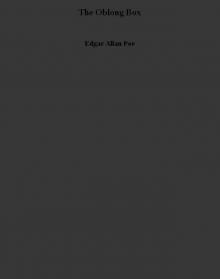 The Oblong Box
The Oblong Box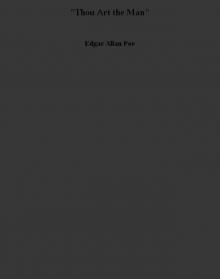 Thou Art the Man
Thou Art the Man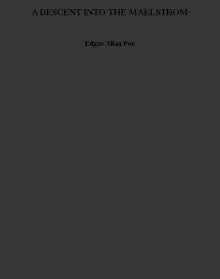 A DESCENT INTO THE MAELSTROM
A DESCENT INTO THE MAELSTROM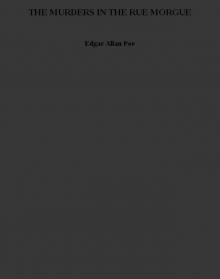 THE MURDERS IN THE RUE MORGUE
THE MURDERS IN THE RUE MORGUE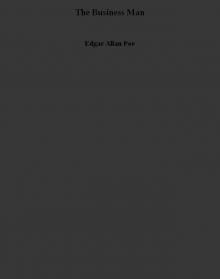 The Business Man
The Business Man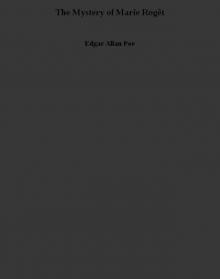 The Mystery of Marie Rogêt
The Mystery of Marie Rogêt Metzengerstein
Metzengerstein The Man That Was Used Up
The Man That Was Used Up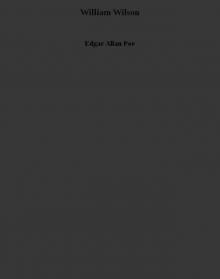 William Wilson
William Wilson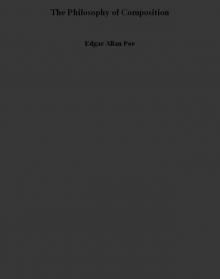 The Philosophy of Composition
The Philosophy of Composition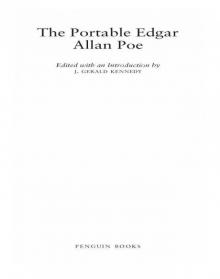 The Portable Edgar Allan Poe
The Portable Edgar Allan Poe Bon-Bon
Bon-Bon A Predicament
A Predicament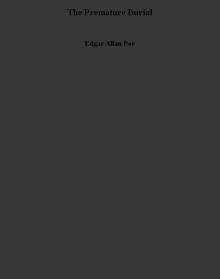 The Premature Burial
The Premature Burial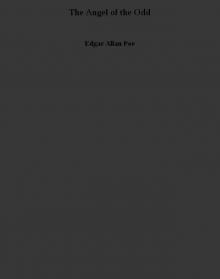 The Angel of the Odd
The Angel of the Odd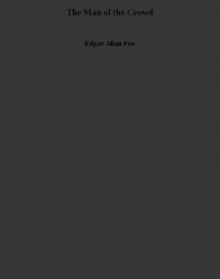 The Man of the Crowd
The Man of the Crowd Never Bet the Devil Your Head
Never Bet the Devil Your Head The Tell-Tale Heart and Other Writings
The Tell-Tale Heart and Other Writings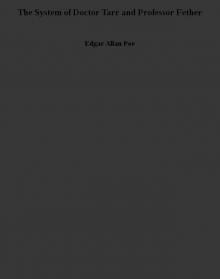 The System of Doctor Tarr and Professor Fether
The System of Doctor Tarr and Professor Fether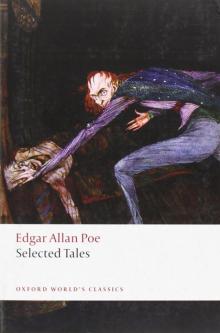 Selected Tales (Oxford World's Classics)
Selected Tales (Oxford World's Classics) Essential Tales and Poems of Edgar Allan Poe (Barnes & Noble Classics Series)
Essential Tales and Poems of Edgar Allan Poe (Barnes & Noble Classics Series) MS. Found in a Bottle
MS. Found in a Bottle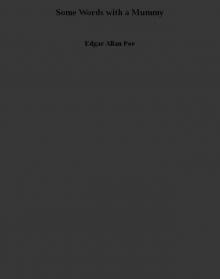 Some Words with a Mummy
Some Words with a Mummy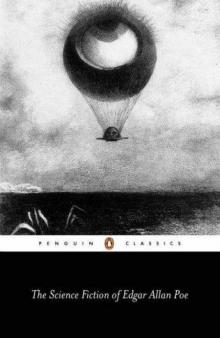 The Science Fiction of Edgar Allan Poe (Penguin Classics)
The Science Fiction of Edgar Allan Poe (Penguin Classics) King Pest
King Pest CRITICISM
CRITICISM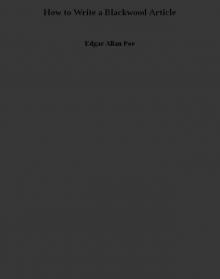 How to Write a Blackwood Article
How to Write a Blackwood Article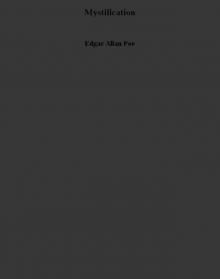 Mystification
Mystification Diddling Considered as One of the Exact Sciences
Diddling Considered as One of the Exact Sciences Steampunk Poe
Steampunk Poe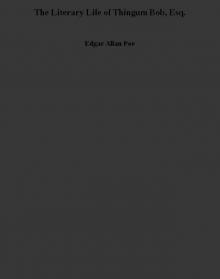 The Literary Life of Thingum Bob, Esq.
The Literary Life of Thingum Bob, Esq.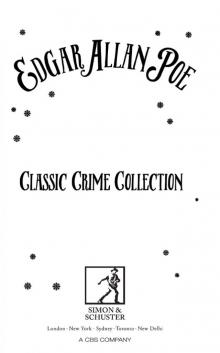 Classic Crime Collection
Classic Crime Collection Complete Stories and Poems of Edgar Allen Poe
Complete Stories and Poems of Edgar Allen Poe Berenice
Berenice The Black Cat
The Black Cat The Slender Poe Anthology
The Slender Poe Anthology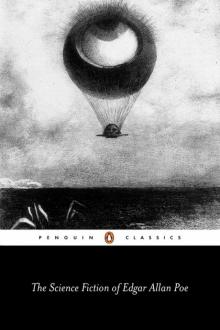 The Science Fiction of Edgar Allan Poe
The Science Fiction of Edgar Allan Poe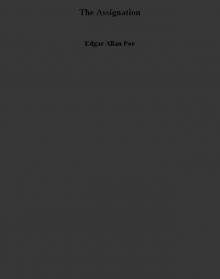 The Assignation
The Assignation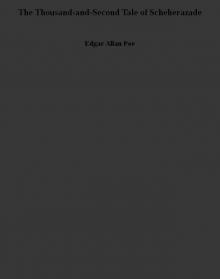 The Thousand-and-Second Tale of Scheherazade
The Thousand-and-Second Tale of Scheherazade The Raven and Other Short Stories
The Raven and Other Short Stories The Spectacles
The Spectacles Hop-Frog
Hop-Frog The Purloined Letter
The Purloined Letter Mellonta Tauta
Mellonta Tauta The Balloon-Hoax
The Balloon-Hoax Landor's Cottage
Landor's Cottage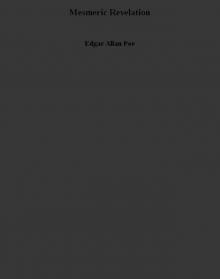 Mesmeric Revelation
Mesmeric Revelation The Pit and the Pendulum
The Pit and the Pendulum